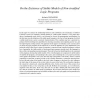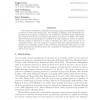JUCS
2010
14 years 1 months ago
2010
: This paper formalizes UML class diagrams and structural patterns as mathematical objects and provides a precise notion of conformance of a structural model specified as a class d...
HIS
2009
14 years 4 months ago
2009
Recent years have witnessed the wide recognition of the importance of ontology and rule in the AI research. In this paper, we report our implementation and evaluation of a rule-ba...
JELIA
2010
Springer
14 years 4 months ago
2010
Springer
In previous work, the so-called Temporal Equilibrium Logic (TEL) was introduced. This formalism provides an extension of the Answer Set semantics for logic programs to arbirary the...
JLP
2000
14 years 6 months ago
2000
In this paper we investigate updates of knowledge bases represented by logic programs. In order to represent negative information, we use generalized logic programs which allow de...
CORR
2002
Springer
14 years 6 months ago
2002
Springer
We introduce a methodology and framework for expressing general preference information in logic programming under the answer set semantics. An ordered logic program is an extended...
CORR
2004
Springer
14 years 6 months ago
2004
Springer
In this paper we analyze the relationship between cyclic definitions and consistency in GelfondLifschitz's answer sets semantics (initially defined as `stable model semantics...
JAIR
2007
14 years 6 months ago
2007
This work is a contribution to prioritized reasoning in logic programming in the presence of preference relations involving atoms. The technique, providing a new interpretation fo...
JAR
2006
14 years 6 months ago
2006
Answer Set Programming (ASP) emerged in the late 1990s as a new logic programming paradigm which has been successfully applied in various application domains. Also motivated by the...
CORR
2010
Springer
14 years 6 months ago
2010
Springer
We propose a method for inferring parameterized regular types for logic programs as solutions for systems of constraints over sets of finite ground Herbrand terms (set constraint s...
AMAI
2008
Springer
14 years 6 months ago
2008
Springer
In a previous paper [BMR01], the authors showed that the mechanism underlying Logic Programming can be extended to handle the situation where the atoms are interpreted as subsets o...






